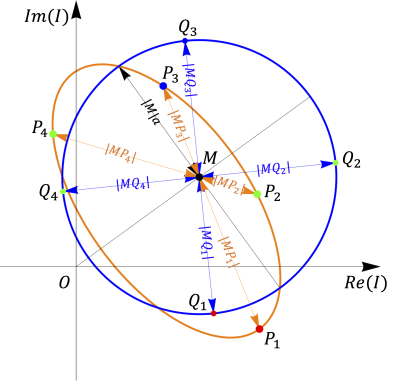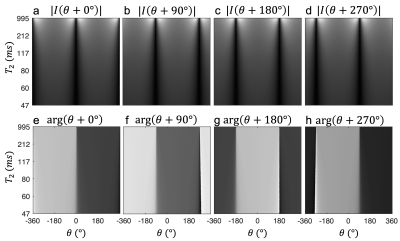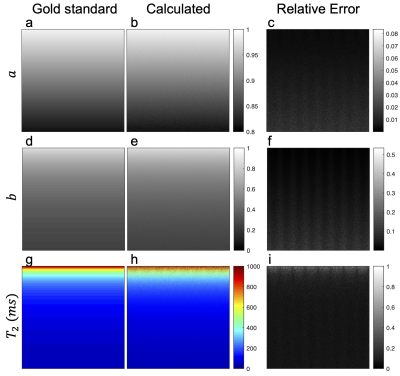2604
Towards analytical $$$T_2$$$ mapping using the bSSFP elliptical signal model1Physics, University of Washington, Seattle, WA, United States, 2Physics, University of British Columbia, Vancouver, BC, Canada, 3Radiology, University of British Columbia, Vancouver, BC, Canada, 4Radiology, University of Washington, Seattle, WA, United States
Synopsis
bSSFP imaging enjoys widespread clinical use due to its high time efficiency and fluid-tissue contrast. Previous work with the elliptic signal model (ESM) and geometric solution (GS) inspire further analytical parameter quantification. Here the first exact solution for relaxation parameter T2 mapping is proposed based on the geometric properties of the ESM. Coupled with artifact-free images and field maps, a comprehensive imaging resource is generated. The analytic solution for source ESM parameters is proven to be relatively robust to variations in noise levels, T2 values and band proximity, and hence inspires a novel solution for T2 computation.
Introduction
Balanced steady state free precession (bSSFP) imaging is an SNR-efficient modality with high fluid-tissue contrast. These properties ensure its diagnostic capacity for imaging in regions such as cardiac and the internal auditory canal (IAC)1. bSSFP would be even more valuable clinically if it provided quantitative tissue and environment parameter maps2. Previously, a geometric solution (GS)3 based on the elliptic signal model (ESM) using 4 phase-cycled bSSFP images demonstrated the capacity to generate artifact-free images with an off-resonance field map4,5. When coupled with complementary ESM computations such as the algebraic solution (AS)6, it is apparent that quantitative MR parameters may be realized analytically using the bSSFP ESM. While numerical methods such as the PLANET7 and DESPOT28 exist, exact bSSFP parametric maps have yet to be calculated. Here the first analytical computation of $$$T_2$$$ relaxation and source ESM parameters using bSSFP is formulated via an exact geometric methodology.Theory
Eq.(1) describes the ESM. $$$\theta=\Delta\omega\cdot{TR}+\psi$$$ is the off-resonant phase accumulation per repetition time $$$TR$$$ for precession frequency off-resonance $$$\Delta\omega$$$, $$$\varphi=-\Delta\omega\cdot{TE}$$$ represents the phase accumulation at echo time $$$t=TE$$$ and $$$\psi$$$ is the phase cycling increment.$$I(\theta,\psi)=M\frac{1-ae^{i(\theta+\psi)}}{b\,\mathrm{cos}(\theta+\psi)}e^{i\varphi}\tag{1}$$
Eq.(2) defines the ESM parameters $$$|M|,a,b$$$, in terms of the equilibrium magnetization $$$M_0$$$, flip angle $$$\alpha$$$, $$$TR$$$, and relaxation times $$$T_1$$$ and $$$T_2$$$.
$$\begin{aligned}E_1&=\mathrm{exp}(-TR/T_1)\\a&=E_2=\mathrm{exp}(-TR/T_2)\\|M|&=\frac{M_0(1-E_1)\,\mathrm{sin}\alpha}{1-E_1\,\mathrm{cos}\alpha-E_2^2(E_1-\mathrm{cos}\alpha)}\\b&=\frac{E_2(1-E_1)(1+\mathrm{cos}\alpha)}{1-E_1\,\mathrm{cos}\alpha-E_2^2(E_1-\mathrm{cos}\alpha)}\end{aligned}\tag{2}$$
Four unique datasets are formed at phase cycling increments $$$\psi_1=0^{\circ},\psi_2=90^{\circ},\psi_3=180^{\circ},\psi_4=270^{\circ}$$$ respectively.
As shown by the orange signal ellipse curve in Fig. 1, point $$$P_i$$$ represents the signal $$$I_i$$$ with the phase cycling increment $$$\psi_i$$$. The blue circle with center at $$$M$$$ obtained by transforming points $$$P_i$$$ on the signal ellipse to points $$$Q_i$$$ is define by $$$J(\theta,\psi)$$$:
$$J(\theta,\psi)=I(\theta,\psi)(1-b\,\mathrm{cos}(\theta+\psi))=|M|e^{i\varphi}(1-ae^{i\theta})\tag{3}$$
The geometric cross-point $$$M=(M_x,M_y)$$$ is calculated via the geometric solution as described by Xiang and Hoff3.
The ratio of the distances $$$|MP_i|$$$ from signal points $$$P_i$$$ to the cross-point $$$M$$$ permits a geometric calculation of $$$b$$$ (and $$$\theta$$$):
$$b\,\mathrm{cos}\theta=\frac{|MP_1|-|MP_3|}{|MP_1|+|MP_3|},b\,\mathrm{sin}\theta=\frac{|MP_4|-|MP_2|}{|MP_2|+|MP_4|}\\b=\sqrt{\left(\frac{|MP_1|-|MP_3|}{|MP_1|+|MP_3|}\right)^2+\left(\frac{|MP_4|-|MP_2|}{|MP_2|+|MP_4|}\right)^2}\tag{4}$$
Coordinates $$$Q_i$$$ may then be computed by multiplying the signal coordinates of point $$$P_i$$$ by $$$(1\pm{b}\,\mathrm{cos}\theta)$$$ or $$$(1\pm{b}\,\mathrm{sin}\theta)$$$ from Eq.(4). The intersection of the circle and ellipse indicates that the circle $$$J$$$ radius $$$|MQ_i|=|M|a$$$. Therefore, $$$a$$$ may be computed once for each of the four transformed phase-cycled points $$$Q_i$$$:
$$\begin{aligned}a_i&=|MQ_i|/|M|\\\overline{a_{rms}}&=\sqrt{(a_1^2+a_2^2+a_3^2+a_4^2)/4}\end{aligned}\tag{5}$$
An $$$a$$$ map can be obtained by calculating the root mean square of $$$a_i$$$, and a $$$T_2$$$ map using Eq.(2) $$$a=\mathrm{exp}(-TR/T_2)$$$.
Methods
Four phase-cycled images are simulated using phase cycling increments $$$\psi=0^{\circ},90^{\circ},180^{\circ}\,\text{and}\,270^{\circ}$$$, flip angle $$$\alpha=30^{\circ}$$$ and $$$TR=10ms$$$. $$$T_1$$$ is held constant at $$$1000ms$$$. $$$T_2$$$ is varied from $$$47ms$$$ to $$$995ms$$$ such that $$$a$$$ varies from $$$0.81$$$ to $$$0.99$$$ and $$$b$$$ varies from $$$0.25$$$ to $$$0.87$$$ vertically. The off-resonant angle $$$\theta$$$ varies from $$$-2\pi$$$ to $$$2\pi$$$ horizontally. Bivariate gaussian noise set to $$$2\%$$$ of the mean intensity is also added.The solution for $$$a,b$$$ and $$$T_2$$$ was computed pixel-by-pixel with signal real parts $$$x_i$$$, imaginary parts $$$y_i$$$ and the geometric solution cross-point $$$M=(M_x,M_y)$$$. The Total Relative Error (TRE) of each analytical solution $$$f_i(x,y)=a,b\,\text{and}\,\theta$$$ over all pixel values $$$x,y$$$ is computed by
$$TRE(f)=\frac{\sqrt{\sum_{x,y}[f_i(x,y)-f_g(x,y)]^2}}{\sum_{x,y}f_g(x,y)}\tag{6}$$
with respect to the gold standard $$$f_g$$$. Extended-size datasets were employed to permit computation of TRE vs. $$$a,T_2$$$ and $$$\theta$$$. $$$11$$$ datasets of similar simulated images were generated with Gaussian noise percentage ranging from $$$0\%$$$ to $$$10\%$$$ for the TRE vs. noise computation.
Results
Fig.3 shows good correspondence between the $$$a,b$$$ and $$$T_2$$$ gold standard and calculated analytical solution maps. Relative error is calculated and shown in the right column, indicating accurate contrast with some increased $$$\theta$$$-dependent variance.Fig.4a and Fig.4b depict the TRE of $$$a$$$ and $$$b$$$ parameters calculated with varying $$$T_2$$$, and are plotted respectively against $$$T_2$$$ itself and the $$$a(T_2)$$$ value. TRE of the solutions gradually decrease as $$$T_2$$$ value increases.
Fig.4c shows a periodic dependency of the $$$a$$$ and $$$b$$$ TRE on off-resonant angle $$$\theta$$$. Fig.4d shows increased TRE as added noise increases.
Discussion
A 4-point geometric solution to $$$a,b\,\text{and}\,T_2$$$ is formulated, which realizes the first analytical computation of the relaxation parameter $$$T_2$$$ using the ESM of bSSFP. The solution to $$$a,b\,\text{and}\,T_2$$$ is exact and without error in noiseless scenarios. With noise present, the $$$a$$$ solution demonstrates relatively little error, whereas the calculated $$$b$$$ shows a stronger periodic variation from the gold standard at $$$\theta=N\pi/2$$$. The ESM indicates that when $$$b\mathrm{cos}\theta$$$ or $$$b\mathrm{sin}\theta$$$ approach zero at $$$N\pi/2$$$, added noise may relatively dominate signal terms. This is exacerbated by squaring the terms in the calculation of $$$b$$$. Note that it is the $$$b$$$-solution variance (and not contrast/level) that depends on $$$\theta$$$, and that the slight $$$\theta$$$-dependence of the GS solution variance6 may also contribute.The calculated $$$T_2$$$ map is accurate when $$$T_2$$$ is small ($$$<200ms$$$). But the inverse logarithm computation $$$a=\mathrm{exp}(-TR/T_2)$$$ causes instability when $$$a$$$ is close to 1. Optimized processing of the averaged $$$a$$$ value should improve $$$T_2$$$ map accuracy.
Conclusion
The first analytic solution for $$$T_2$$$ using the ESM of bSSFP is shown to be relatively robust for calculations of ESM parameters $$$a$$$ and $$$b$$$ under variation of noise levels, $$$T_2$$$ values and band proximity. This inspires clinical application of this novel GS-scaled method to add bSSFP parametric maps to artifact-free images.Acknowledgements
No acknowledgement found.References
1. Scheffler K, Lehnhardt S. Principles and applications of balanced SSFP techniques. European Radiology, 2003; 13(11):2409–2418.
2. Margaret Cheng H‐L, Stikov N, Ghugre NR, Wright GA. Practical medical applications of quantitative MR relaxometry. J. Magn. Reson. Imaging, 2012; 36: 805-824.
3. Xiang Q-S, Hoff MN. Banding Artifact Removal for bSSFP Imaging with an Elliptical Signal Model. Magn Reson Med, 2014; 71(3):927:933.
4. Hoff MN, Xiang Q-S. Correcting bSSFP Distortion near Metals with Geometric Solution Phase. In: Proc. ISMRM, Salt Lake City, USA, 2013. p. 2563
5. Taylor M, Valentine J, Whitaker S, Hoff MN, Bangerter N. Field Mapping using bSSFP Elliptical Signal Model. In: Proc. ISMRM, Hawaii, HI, USA, 2017. P. 3920.
6. Hoff MN, Andre JB, Xiang Q-S. Combined Geometric and Algebraic Solutions for Removal of bSSFP Banding Artifacts with Performance Comparisons. Magn Reson Med, 2017; 77:644-654.
7. Shcherbakova Y, van den Berg CA, Moonen CT, Bartels LW. PLANET: An ellipse fitting approach for simultaneous T1 and T2 mapping using phase‐cycled balanced steady‐state free precession. Magn Reson Med, 2018; 79:711-722.
8. Deoni SCL, Rutt BK, Peters TM. Rapid combined T1 and T2 mapping using gradient recalled acquisition in the steady state. Magn Reson Med, 2003; 49:515–526.
Figures



